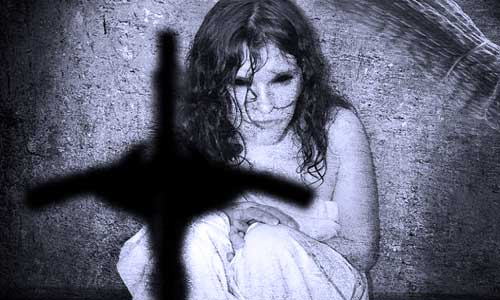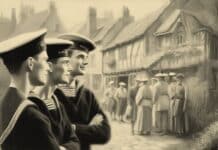JON KANEKO-JAMES looks at historic cases of children being possessed by demons – and discovers some potentially easy explanations.

Possessed children are a staple in modern horror: from The Exorcist’s Regan in her blue dress to the unfortunate girl in The Exorcism of Emily Rose, possessed children have a lot of currency at the movies – and the younger the better.
From the Medieval to the Early Modern period possession was a very real thing. Young, attractive women were consisted the most vulnerable but children were certainly next on the list.
The historian Kathleen R. Sands theorises that a great many Early Modern demoniacs were children because of the pressures placed on them in Puritan communities: the education of children was based on the idea that the young were inherently immoral and bestial in nature.
The ‘correct’ moral complex would have to be ground into the child through a regime that modem observers would find tyrannical, if not borderline abusive: children were not permitted to furrow their brows, whistle through their noses, puff out their cheeks, press their lips together, yawn, laugh excessively or let their hair fall on their foreheads. Violation of these rules was seen as indicating any number of character flaws.
These children’s daily routine was punishingly full: they were made to rise early, pray, attend lessons and memorise new bible verses in their spare time, punish themselves for infractions, undertake household chores and were discouraged from any kind of solitary activities except study and reading.
Whether or not we believe in demons, pressure of that kind will find a release.
The Throckmorton Children
In November 1589 in Warboys, Essex, Jane Throckmorton began to suffer ‘a strange kind of sickness and distemprement of the body.’ Descriptions of her illness describe convulsions severe enough to damage furniture and even after repeated testing by medical professionals, doctors had little to offer other than the possibility of witchcraft and demonic possession.
In fact, Jane’s mother resisted the idea of possession for a great length of time: she sent her daughter to Dr Philip Barrow for treatment for the sickness of epilepsy, but to no avail. Eventually, another facet of her child’s sickness gained notice – her repeated accusations of witchcraft against an elderly local woman known as Alice Samuel.
In fact, with a month of Jane Throckmorton’s first symptoms, two more of their daughters had fallen into similar states of possession.
By February the following year, the Throckmorton parents were in such a state of desperation that when Jane was in a convulsive fit they brought her Alice Samuel so that Jane could try the traditional -but unlawful – remedy of ‘scratching’, whereby a victim of witchcraft would make a vicious and bloody scratch on a witch’s skin to drive away any malefic magic.
The children utterly subverted their relationship with the elderly Mother Samuel, and also their parents: the girls had regular ecstatic outbursts where they would vocally criticise the old woman, something unheard of at the time.
The children also took an otherwise unthinkable level of control over their daily routine. They said that they could only eat in the shadow of a certain tree and could not bear to hear the sound of Scripture being read. The punishments for parental infractions were puritanically severe: convulsive fits, screaming visions of Alice Samuel and clenching their jaws so tightly that ‘they could not be fed milk through a quill’.
Gradually, the condition of possession spread, first amongst the daughters and then to seven of the family’s maid servants, all sneezing, coughing and writhing on the floor.
One daughter was sent away to an uncle Gilbert, where she stopped all religious exercises and forced her uncle’s family to accompany her on picnics every day. During this time the girl, Elizabeth, could see only one adult, who was forced to play cards with her the whole day through.
If, as D P Walker says, this sounds ‘very jolly’, we must remember that it cost lives. Alice Samuel and her whole family were executed – hanged for witchcraft in the possession of the Throckmorton Children and the death by witchcraft of a Lady Cromwell, who had accused Samuel of being a witch during a visit to the household and died soon after.
Thomas Darling, the Boy of Burton
In February 1596 in Burton, 13-year-old Thomas began suffering convulsions where he would lose the use of his legs. During these fits, accompanied by visions of angels and a green cat, the boy would show many of the textbook signs of demonic possession.
After an abortive attempt to have him treated for epilepsy, a local physician tested the young man’s urine and, without a doubt, found him to be suffering ‘demonic obsession’.
After overhearing his aunt discussing the matter, he confessed that he had seen a local woman with three warts on her face, who heard him breaking wind and uttered a strange curse:
“Gyp with a mischief, and fart with a bell, I will go to heaven, and thou shalt go to hell.”
This woman was identified as Alice Gooderidge, who was viciously scratched to try and remove the boy’s possession, and who readily confessed to the justices that she had spoken roughly to young Thomas after mistaking him for someone else. After some cajoling by the Justices, the unfortunate Gooderidge described receiving familiar spirits from the devil, who allowed her to use them to torment Darling.
In fact, Thomas Darling gets top marks for making the most of his possession: be gathered a following and attracted large crowds.
His demonic fits were also remarkably regular. He would fall into fits at the reading of specific verses of the Gospel of St John, with his performances being so effective that a disbeliever was moved to tears during one, confessing himself a sceptic no more.
Again, it would be tempting to paint this as a case of clever children winning over their stiff Puritan elders, but whether demons were involved or not, the end of the Darling possession was dark for some. Thomas was dispossessed by the vision of a dove, providing a satisfying end to the narrative for Puritan fans.
The end was less cathartic for Alice Gooderidge, who died in prison, not that her living would have been any better. As the pamphelteer Jesse Bee wrote, ‘had the old witch lived, she would have been hanged.’









